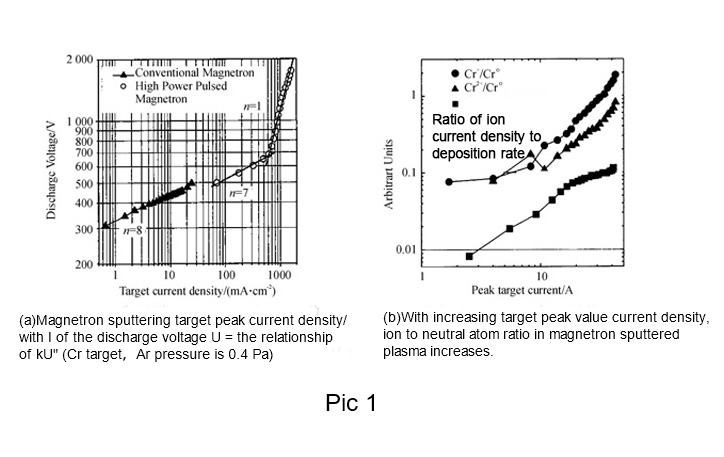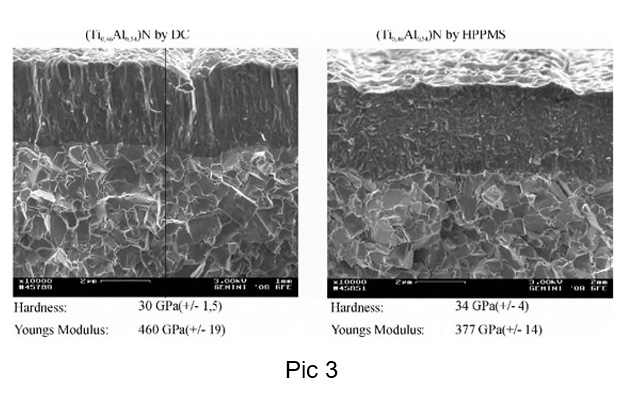No.1 Principle of high power pulsed magnetron sputtering
The high power pulsed magnetron sputtering technique uses high peak pulse power (2-3 orders of magnitude higher than conventional magnetron sputtering) and low pulse duty cycle (0.5%-10%) to achieve high metal dissociation rates (>50%), which is derived from the magnetron sputtering characteristics, as shown in Pic 1, where the peak target current density I is proportional to the exponential nth power of the discharge voltage U, I = kUn (n is a constant related to the cathode structure, magnetic field and material). At lower power densities (low voltage) the n value is usually in the range of 5 to 15; with the increasing discharge voltage, the current density and power density increase rapidly, and at high voltage the n value becomes 1 due to the loss of magnetic field confinement. If at low power densities, the gas discharge is determined by gas ions that is in the normal pulsed discharge mode; if at high power densities, the proportion of metal ions in the plasma increases and some materials switch,that is in the self-sputtering mode, i.e. The plasma is maintained by the ionization of sputtered neutral particles and secondary metal ions, and inert gas atoms such as Ar are used only to ignite the plasma, after which the sputtered metal particles are ionized near the target and accelerated back to bombard the sputtered target under the action of magnetic and electric fields to maintain the high current discharge, and the plasma is highly ionized metal particles. Due to the sputtering process of the heating effect on the target, in order to ensure the stable operation of the target in industrial applications, the power density directly applied to the target can not be too large, generally direct water cooling and target material thermal conductivity should be in the case of 25 W / cm2 below, indirect water cooling, target material thermal conductivity is poor, target material caused by fragmentation due to thermal stress or target material contains low volatile alloy components and other cases of power density can only be in 2 ~ 15 W / cm2 below, far below the requirements of high power density. The problem of target overheating can be solved by using very narrow high power pulses. Anders defines high-power pulsed magnetron sputtering as a kind of pulsed sputtering where the peak power density exceeds the average power density by 2 to 3 orders of magnitude, and the target ion sputtering dominates the sputtering process, and the target sputtering atoms are highly dissociated.
No.2 The characteristics of high power pulsed magnetron sputtering coating deposition

High power pulsed magnetron sputtering can produce plasma with high dissociation rate and high ion energy, and can apply bias pressure to accelerate the charged ions, and the coating deposition process is bombarded by high-energy particles, which is a typical IPVD technology. The ion energy and distribution have a very important impact on the coating quality and performance.
About IPVD, based on the famous Thorton structural region model, Anders proposed a structural region model that includes plasma deposition and ion etching, extended the relationship between coating structure and temperature and air pressure in the Thorton structural region model to the relationship between coating structure, temperature and ion energy, as shown in Pic 2. In the case of low energy ion deposition coating, the coating structure conforms to Thorton structure zone model. With the increasing of deposition temperature, the transition from region 1 (loose porous fiber crystals) to region T (dense fiber crystals), region 2 (columnar crystals) and region 3 (recrystallization region); with the increasing of deposition ion energy, the transition temperature from region 1 to region T, region 2 and region 3 decreases. The high-density fiber crystals and columnar crystals can be prepared at low temperature. When the energy of deposited ions increases to the order of 1-10 eV, the bombardment and etching of ions on the deposited coatings surface is enhanced and the thickness of coatings is increased.

No.3 Preparation of hard coating layer by high power pulsed magnetron sputtering technology
The coating prepared by high power pulsed magnetron sputtering technology is denser, with better mechanical properties and high temperature stability. As shown in Pic 3, the conventional magnetron sputtered TiAlN coating is a columnar crystal structure with a hardness of 30 GPa and a Young’s modulus of 460 GPa; the HIPIMS-TiAlN coating is 34 GPa hardness while the Young’s modulus is 377 GPa; the ratio between hardness and Young’s modulus is a measure of the toughness of the coating. Higher hardness and smaller Young’s modulus mean better toughness. The HIPIMS-TiAlN coating has better high temperature stability, with AlN hexagonal phase precipitated in the conventional TiAlN coating after high temperature annealing treatment at 1,000 °C for 4 h. The hardness of the coating decreases at high temperature, while the HIPIMS-TiAlN coating remains unchanged after heat treatment at the same temperature and time. HIPIMS-TiAlN coating also has a higher onset temperature of high temperature oxidation than conventional coating. Therefore, the HIPIMS-TiAlN coating shows much better performance in high-speed cutting tools than other coated tools prepared by PVD process.

Post time: Nov-08-2022

